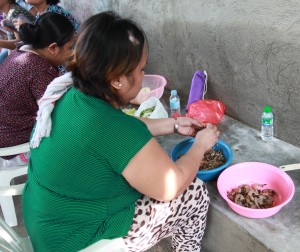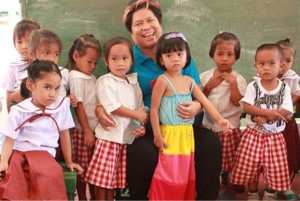Children sit in groups in small tables, writing and coloring, while their mothers are busy preparing their lunch for the day.
This was the scene at Franvile Day Care Center, Barangay 177 in Camarin, North Caloocan one bright morning, where 137 day care children, three to five years old, are beneficiaries of the Supplementary Feeding Program (SFP) implemented by the Department of Social Welfare and Development (DSWD) and the local government unit (LGU) of Caloocan City.
SFP, which started in 2011, is a major anti-hunger program of DSWD that provides food supplementation in the form of hot meals to be served during snack and meal time to children enrolled in LGU-managed day care centers and supervised neighborhood play groups, five days a week for 120 days.
The program beneficiaries are three- and four-year-old children, and five-year-old children not included in the Department of Education (DepEd) pre-school curriculum, but enrolled in day care.
This program is implemented in response to the 2006 Family Income and Expenditure Survey (FIES) conducted by the Philippine Statistics Authority (PSA), which showed that 11 percent of Filipino families are “food poor” which means that their income is not sufficient to buy the food needed by family members for nutritional well-being and health.
Meal time
According to Marilyn Calitoy, Caloocan City SFP and Day Care Service Focal Person, the LGU, through the City Social Welfare and Development Office (CSWDO), has been conducting its school feeding program for almost three years now.
The feeding session continues even during the summer break. Some Grade 1 pupils who graduated from the day care center also continue to benefit from the program.
“Franville DCC holds three sessions for each batch of pre-schoolers. Each session, including lessons, play time and meal time, lasts for three hours”, explained Erlyn Alcantara, a day care worker.
The children are weighed monthly. Out of the 137 enrolled pre-schoolers, 127 are normal, six are below normal (BN) and four are below normal very low level (BNVL).
“We are very happy with the very obvious improvements in the health of our students,” Erlyn enthused. “For instance, Ericka, 5, weighs only 12.5 pounds when she entered Franville DCC last year. As of April this year, she now weighs 15.5 pounds.”
To enforce the gains of the program, the children are not allowed to bring junk food and soft drinks as snacks.
“We also encourage the parents to set a good example, when the kids see them eating nutritious food, such as vegetables, they will follow,” Erlyn affirmed.
Aside from the nutritional benefit of SFP, it also aims to improve the knowledge, attitude and practices of children, parents and caregivers through intensified nutrition and health education, which will lead to improved and sustained nutritional status of the target beneficiaries.
Complementary activities are also undertaken to fully maximize SFP’s impact. These include biannual deworming, micronutrient supplementation specifically provision of vitamin A, growth monitoring, conduct of Parent Effectiveness Seminars (PES) and Family Development Sessions (FDS), and Pabasa sa Nutrisyon, among others.
Parents’ role
“Parents play a pivotal role in the growth and development of their children. They are the first teachers and our partners, hence they should actively participate in the activities at the DCC,” Erlyn stated.
Part of their commitment when they enrol their children is to help in the preparation of meals, attend the PES sessions, and maintain the cleanliness in the day care center.
“If they cannot attend the sessions, a caregiver or a member of the family should be there,” she explained.
Erlyn narrated that PES sessions are very helpful in changing the mind set of parents regarding disciplining their children. The modules cover the Convention on the Rights of the Child (CRC), Early Childhood Care and Development (ECCD), Family Development, and Disaster Preparedness.

Marigel Mariano, a single mother to five-year-old Sophia tearfully related her experience in the positive discipline sessions.
“Aminin ko na dati, sinisigawan ko ang anak ko, at nasasaktan ko rin minsan gawa nga ng kakulitan niya. Ngunit nang dumalo ako ng PES ay naliwanagan ako na hindi ko dapat sinasaktan at sinisigawan ang bata. Hindi ko dapat ginagawa ang mga bagay na eto dahil may masamang epekto ito sa bata (I admit that before, I shout at and physically hurt my child. But when I attended the PES sessions, it became clear to me that I should not do these things because of the negative effects).”
Marigel, who works as a house helper, finds time to assist in the preparation of meals and participates in PES sessions and other activities.
“Nagpapasalamat ako sa DSWD at LGU ng Caloocan sa pagpapatupad ng programang ito. Dahil sa SFP, hindi lang kalusugan ng anak ko ang napabuti kung ‘di pati na ang pananaw ko sa pagdidisiplina at pagpapalaki sa aking anak. (I am thankful to the DSWD and the Caloocan LGU for implementing this program. Because of SFP, it’s not only my child’s health which improved, but also my viewpoint on disciplining and nurturing my daughter).
Funds
To fully implement the SFP, DSWD downloads the funds to each recipient LGU, which shall procure the needed goods with proper supporting documents as required under the existing budgeting, accounting and auditing rules and regulations.
The LGUs shall take full responsibility in the proper disbursement and liquidation of funds for the program’s implementation.
Strong LGU support
Caloocan City is an example of an LGU which fully supports the SFP.
According to Calitoy, their mayor is very supportive of the program.
“We hold monthly meetings of day care workers in all barangays, and we also conduct trainings to capacitate them,” Calitoy expounded.
She added, “We hope SFP will continue because we can really see the improvement in the children.”
The strong LGU support to the program is evident down to the barangay level.
“The Barangay Council shoulders the costs of water and electricity so the parents would not have to pay for them,” Erlyn expounded.
LGU initiatives
Aside from the SFP, LGUs have their own feeding programs, such as the one in Naga City.
On August 20, 2013, Mayor John Bonggat and DepEd-Region V launched the “Taranoman para sa Tamang Nutrisyon” project participated in by 29 selected public elementary schools in the city.
Mayor Bongat encouraged the concerned city offices and DepEd to grow nutritious plants that can be used as ingredients for the school feeding menu given to children under the Nutri-Dunong program of the City Population and Nutrition Office.
Under the project “Backyard Gardening”, they planted vegetables, such as pechay, squash, tomatoes, cassava, kangkong, carrots, cabbage, malunggay, monggo, beans, corn, camote, ginger, pepper (for its leaves), gabi, upo, sayote, raddish, Baguio beans, and eggplant in school gardens. The harvested vegetables are used as ingredients in the school feeding program to improve the nutrition level among public school children.
The project is also aimed at allowing school personnel and the children to appreciate gardening as a means of producing healthy food for the home and community.
Nationwide implementation

About 1,755,034 children in 45,389 day care centers nationwide benefitted from the SFP for school year 2013-2014.
In the 2013 DSWD budget, it has allocated more than P2.9 billion for the program covering all 17 regions including the Autonomous Region in Muslim Mindanao (ARMM).
“With this program we are helping solve hunger among young children,” DSWD Secretary Corazon Juliano-Soliman said. Likewise, this is part of government’s efforts to capacitate program beneficiaries instilling in them the willingness to change for the better.
As Marigel enthused after looking back at how the program helped them, “Kaya ko pala ang pagbabago.” ###


